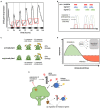Biological Prescience: The Role of Anticipation in Organismal Processes
- PMID: 34975512
- PMCID: PMC8719636
- DOI: 10.3389/fphys.2021.672457
Biological Prescience: The Role of Anticipation in Organismal Processes
Abstract
Anticipation is the act of using information about the past and present to make predictions about future scenarios. As a concept, it is predominantly associated with the psychology of the human mind; however, there is accumulating evidence that diverse taxa without complex neural systems, and even biochemical networks themselves, can respond to perceived future conditions. Although anticipatory processes, such as circadian rhythms, stress priming, and cephalic responses, have been extensively studied over the last three centuries, newer research on anticipatory genetic networks in microbial species shows that anticipatory processes are widespread, evolutionarily old, and not simply reserved for neurological complex organisms. Overall, data suggest that anticipatory responses represent a unique type of biological processes that can be distinguished based on their organizational properties and mechanisms. Unfortunately, an empirically based biologically explicit framework for describing anticipatory processes does not currently exist. This review attempts to fill this void by discussing the existing examples of anticipatory processes in non-cognitive organisms, providing potential criteria for defining anticipatory processes, as well as their putative mechanisms, and drawing attention to the often-overlooked role of anticipation in the evolution of physiological systems. Ultimately, a case is made for incorporating an anticipatory framework into the existing physiological paradigm to advance our understanding of complex biological processes.
Keywords: allostasis; cephalic responses; feed-forward control; microbe; non-cognitive; physiological regulation; prediction.
Copyright © 2021 Deans.
Conflict of interest statement
The author declares that the research was conducted in the absence of any commercial or financial relationships that could be construed as a potential conflict of interest.
Figures





References
-
- Ahlers V., Parlitz U., Lauterborn W. (1998). Hyperchaotic dynamics and synchronization of external-cavity semiconductor lasers. Phys. Rev. E Stat. Phys. Plasmas Fluids Relat. Interdiscip. Topics 58, 7208–7213. doi: 10.1103/PhysRevE.58.7208 - DOI
-
- Ahn J. B., Hwang H. J., Park J. H. (2001). Physiological responses of oxygen-tolerant anaerobic Bifidobacterium longum under oxygen. J. Microbiol. Biotechnol. 11, 443–451.
-
- Albanesi D., Reh G., Guerin M. F., Schaeffer F., Debarbouille M., Buschiazzo A., et al. . (2013). Structural basis for feed-forward transcriptional regulation of membrane lipid homeostasis in Staphylococcus aureus. PLoS Pathog. 9:e1003108. doi: 10.1371/journal.ppat.1003108, PMID: - DOI - PMC - PubMed
-
- Albrecht U. (2010). The Circadian Clock. Vol. 12. New York: Springer Science & Business Media.
Publication types
LinkOut - more resources
Full Text Sources
Research Materials
Miscellaneous

